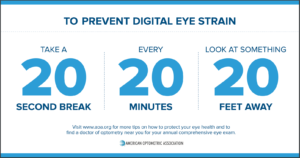Wow Vision Therapy Blog
Excessive Digital Screen Time Causes Vision Problems in Children

Since the COVID-19 pandemic lockdown measures, there’s been a dramatic increase in digital screen time applications, particularly with children in their new learning environments.
For example, in our clinical locations, we regularly hear from parents of children in elementary school that their children are on digital devices about 5-8 hours a day. This translates to 35-40 hours per week or about the same amount of time an adult spends in a full-time job. Still, in this case, elementary school children are in front of a digital screen. These same children are coming into our clinics because they are experiencing visual-based symptoms. Some show increases in distance blur due to myopia (nearsightedness). These visual changes often require a stronger prescription in their glasses.
Another seemingly more significant set of children do not have a distance blur. Instead, near vision blur, headaches, eye strain, and difficulty with visual efficiency issues involving eye teaming, focusing, and tracking abilities. Another even smaller group manifests more severe vision disorders in which a child develops an eye turn. And with the increased demand for distance learning, these conditions may develop from excessive screen time.
The Effects of Excessive Screen Time
The problem with excessive screen time is that it causes something called Near Point Visual Stress. This condition is a response the visual system has when looking closely at something for long periods. As a result, near-point visual stress causes a mismatch between the eye teaming and eye focusing systems. From this, a child may start to see things blurry or start seeing two of everything while reading, known as double vision.
These vision problems can also lead to behavioral and emotional issues triggering anxiety, reduced self-esteem, and even depression to make things worse. Another side-effect is reduced attention and concentration for reading-related activities.
 Moving this into the year 2020, the COVID pandemic has rapidly accelerated Near Point Visual Stress by requiring excessive digital screen time with distant learning on kids. This has accelerated these visual conditions to even more significant concerns than ever before. Therefore, to help offset the impact of Near Point Visual Stress, a common-sense approach is to recommend “visual stress relief” from digital devices as part of the Near Point Visual Stress management strategy. One such example is applying the 20/20/20 rule for visual breaks every 20 minutes by looking 20 feet away (or more) for 20 seconds.
Moving this into the year 2020, the COVID pandemic has rapidly accelerated Near Point Visual Stress by requiring excessive digital screen time with distant learning on kids. This has accelerated these visual conditions to even more significant concerns than ever before. Therefore, to help offset the impact of Near Point Visual Stress, a common-sense approach is to recommend “visual stress relief” from digital devices as part of the Near Point Visual Stress management strategy. One such example is applying the 20/20/20 rule for visual breaks every 20 minutes by looking 20 feet away (or more) for 20 seconds.
When It’s Time to See a Doctor
First, it’s essential to realize that there are many educational benefits to having access to digital technology for enhanced learning opportunities. These new virtual learning platforms have expanded access to information and methods to stay connected and a plethora of knowledge-based resources. At the same time, if unaddressed, there can be a host of visual consequences.
However, parents need to have their children seen for a Comprehensive Eye Health and Vision Evaluation if their child shows mild symptoms of Near Point Visual Stress. A primary care optometrist can perform this assessment and may prescribe stress-relieving lenses, often with “blue-blocking” filters, which can reduce digital screen light intensity and help cushion the impact of Near Point Visual Stress.
When lenses aren’t enough, and a child has worsening problems with blurriness, near double vision, eye strain headaches, poor attention, concentration, or an eye turn, a Developmental Vision/Rehabilitation Optometrist should see them. Like the ones here at Wow Vision Therapy, this type of optometrist will conduct a Developmental Vision Evaluation and may even recommend Vision Therapy.
In this era of expanded digital screen time, there are risks to a child’s visual development. With proper measures, together, we can find solutions to end the senseless struggle that affects so many children from induced Near Point Visual Stress – because life takes vision!
GET IN TOUCH
To learn more, please fill out the form below and one of our Patient Care Coordinators will be in touch to answer your questions or help schedule an evaluation for you.
